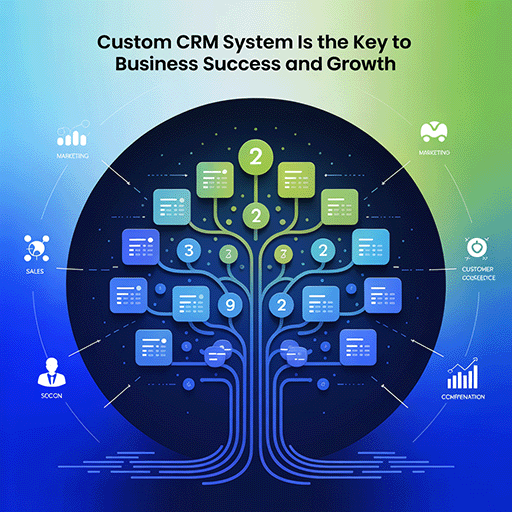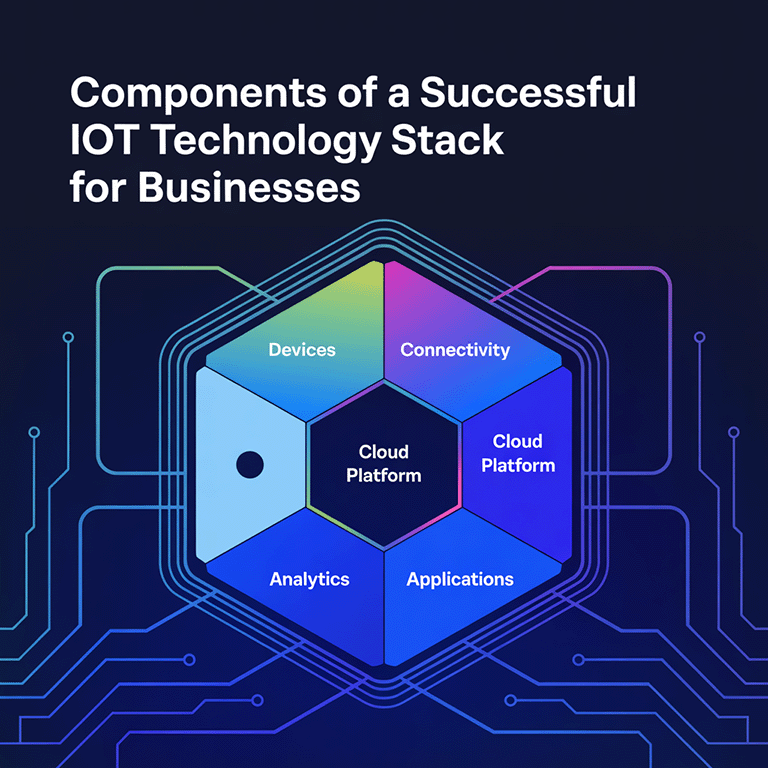Netflix, Etsy, Walmart, and Uber—these major players benefit from using a microservices-based architecture to get easy integration, automatic deployment, and flexible scaling. In this article, we have expanded on the key features of microservices architecture, its tools, benefits, challenges, and the most significant examples of microservices in action.
What Is Microservices Architecture All About?
Microservices architecture is a type of application infrastructure where a solution consists of a set of independently deployable services that can run on their own.
Such solutions are faster to develop and easier to deploy as code can be updated in a single service without rebuilding the entire solution. Such a combination of services enables developers to build scalable apps with extensive functionality.
There are a variety of programming languages, platforms, and tools out there that allow building microservices apps of different scope and complexity. Instead of managing a large team building a monolithic solution, it’s much easier to maintain a smaller team of developers working on a set of independent applications.
Have a look at some of the microservices features:
-
- Each service is a separate codebase
- Well-defined APIs enable data transmission among services
- Services are autonomous so each component deals with its own data
- Developers can use various programming languages, technology stacks, and frameworks for different components, deploying each service independently
- Microservices are all about business priorities as they are deployed according to business requirements. Instead of having a certain focus, microservices teams include specialists with different expertise working toward a common goal.
Microservices Architecture vs Monolithic Approach: What’s the Difference?
Software with monolithic architecture in the core is built as a single system. This immense codebase repository involves standardized software development kits and dependencies, making it more challenging to deploy and scale. Minor changes would require rebuilding the entire application.

A monolithic approach is a great option in case your project doesn’t involve advanced scalability and hundreds of developers. If you are satisfied with your core system and just want to overhaul the UI, there’s no need to adopt microservices. It is a quick fix, and it is not worth the hassle of migrating from a monolith architecture to microservices.
Though if you have a scalable application with lots of advanced features, the monolithic approach can slow down the development process and make a huge codebase suffer from numerous bugs and vulnerabilities.
When you opt for a microservices architecture, each service performs a specialized task, communicating via APIs. If a single microservice fails, the other microservices are still available and can be scaled independently.
Microservices Tools
A microservices architecture doesn’t require standardized software development kits to operate, but there are still some core components applied for most systems.
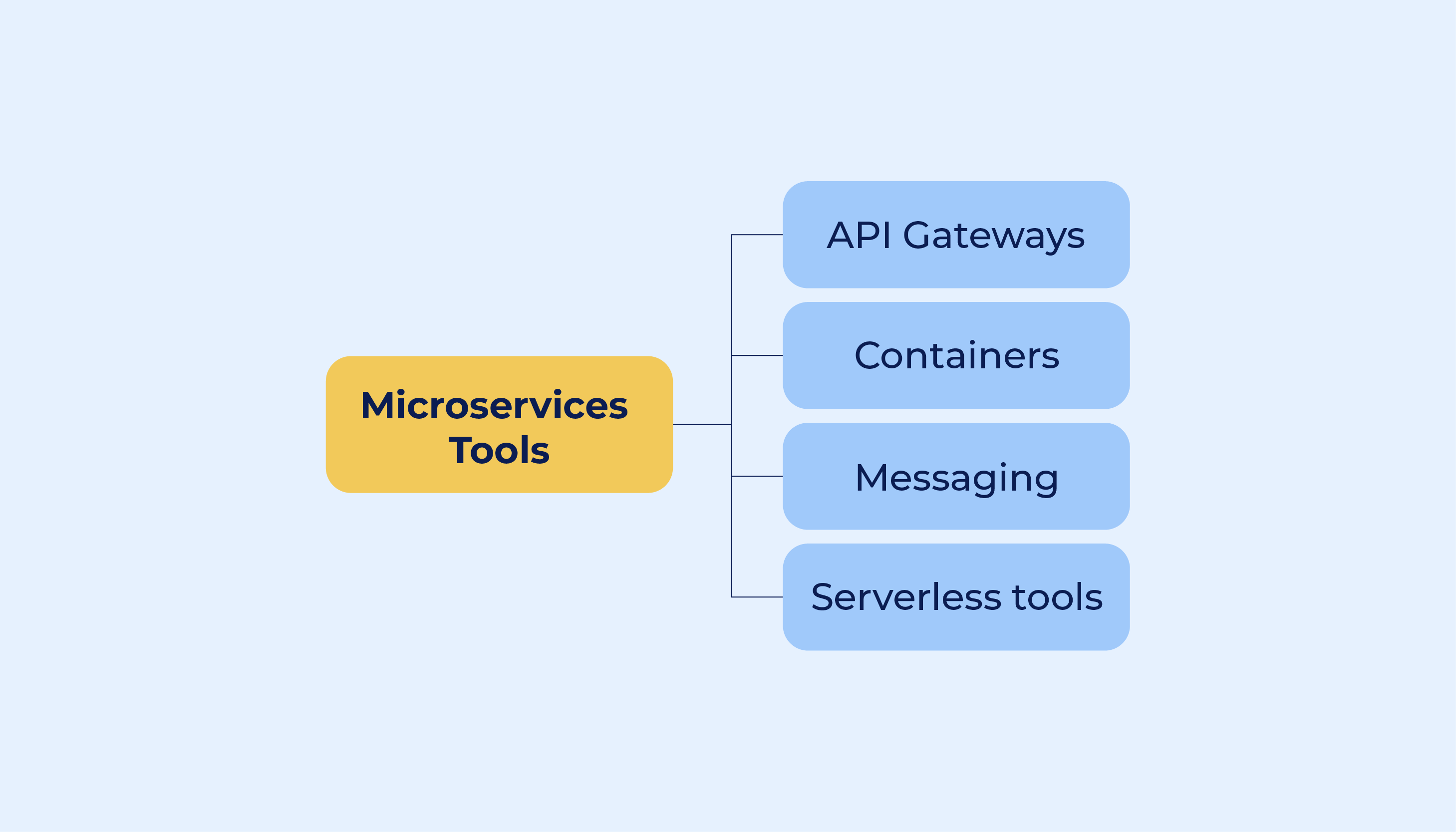
-
API Gateways
Being an intermediary level between clients and services, API gateways provide extra security and route clients’ requests to the appropriate microservices. For example, Tyk is one of the most scalable and secure cloud-native API management platforms.
Whether you want to migrate from a monolith architecture to microservices or want to build the one from scratch, this open-source API will let you scale up and down whenever your app requires.
With such features as circuit breakers, uptime tests, and service discovery, you will simplify the development process and adopt microservices faster.
-
Containers
Container development is the most suitable way for running microservices. It enables apps to be rapidly scaled and needs fewer system resources than virtual machines.
Docker and Kubernetes are the main technologies when it comes to containerization. A major difference between them is that Docker is meant to run on a single node, while Kubernetes runs across clusters.
Though it’s common to compare Kubernetes and Docker, it doesn’t mean that you have to choose a single technology as they can work together. Docker is a container platform to develop and deploy apps faster, while Kubernetes is a container orchestrator for such platforms as Docker.
Implementing a microservices architecture with both of these technologies, you will make your app and infrastructure more scalable and robust. If some of your nodes are down, your app will stay online. What’s more, if you need to scale your app for a better UX, you will just have to add nodes to your Kubernetes cluster.
-
Messaging
To let services collaborate and handle clients’ requests, you will have to implement asynchronous messaging technologies.
Apache Kafka, an open-source event streaming platform, will let you handle communication between microservices, scale production clusters, and store a large amount of data in a cluster. With Kafka, you can also use event streaming to process payments in real-time, maintain data from IoT devices, and analyze customer interactions.
-
Serverless Tools
Serverless tech is one of the most significant parts of a microservices architecture. It optimizes the process of breaking a single application into multiple independent services. Serverless microservices only run when they are required and can be divided into a number of smaller functions.
Iron Functions is a serverless computing platform that supports functions in any programming language, and can be easily implemented into your app.
After implementing Iron Functions, you just have to set up your infrastructure and job processing. Integration with such tools as Kubernetes and Docker Swarm will speed up the development process a lot.
Benefits of Microservices
-
Flexible scaling
Developers can scale microservices independently without affecting the entire infrastructure. Resource management improves a lot as engineers can pack more services onto a single host using Kubernetes for microservices architecture.
-
Agility
Because of microservices independence, it’s much easier to fix bugs and implement new features. Your release process won’t be slowed down by a bug in a certain part of the application.
-
Small teams
Large teams with hundreds of developers are difficult, hard to communicate with, which makes them less productive.
In contrast, smaller teams working on numerous independent applications can implement new features, test them, and fix bugs faster as they focus on a particular service and act within a familiar context.
-
A mix of languages and technologies
Such technological freedom enables developers to pick the technology, tool, and programming language that can solve their specific issues. Using the best tool for each service, teams work faster and avoid lots of inefficiencies.
-
Fault isolation
If a single microservice fails, other components will handle it by degrading functionality instead of crushing the entire application. This resilience enables developers to build and deploy services as necessary and examine specific errors more thoroughly.
-
Reusable code
Dividing the entire application into numerous independent microservices allows developers to use such features as payment or login systems for multiple purposes. As a result, teams can implement new features without writing code from scratch, which speeds up the development process.
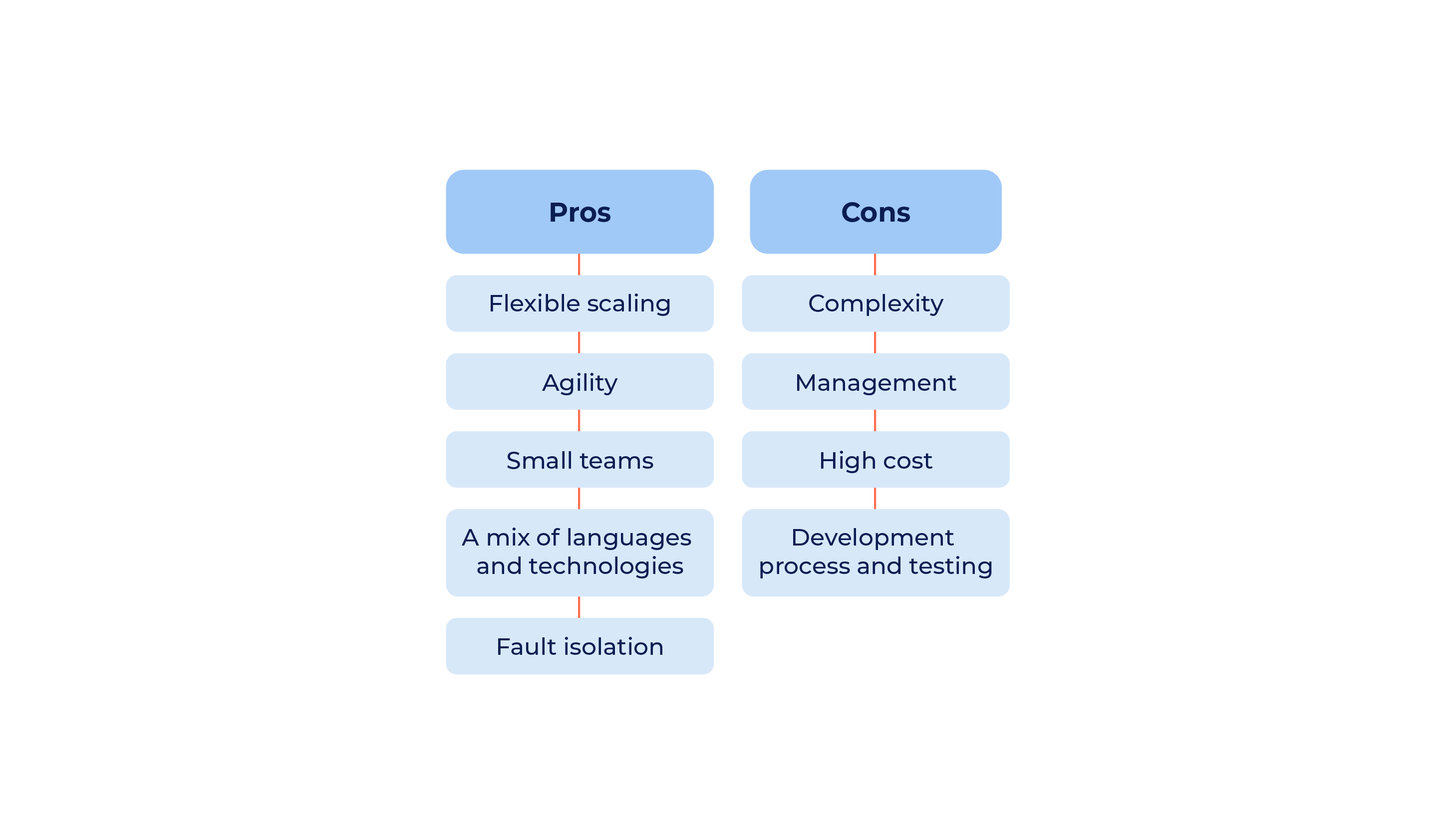
Challenges of Microservices
-
Complexity
The microservices approach means there are more independent components to manage. Each service is easier to maintain, but the entire system is more complex than the monolithic approach. Thus, teams have to implement more automated solutions to counterbalance this complexity.
-
Management
With an increased number of services, managing the entire product can become more challenging. Issues in one service can cause problems in other components and new versions can lead to backward compatibility issues.
To make your microservices-based solution successful, you will need a strong DevOps approach to help your development, IT operations, and QA teams collaborate more efficiently and accelerate your time to market.
-
High cost
Microservices-based solutions are more costly than the monolithic approach as microservices work through API calls and usually need their own CPUs.
Depending on your project’s goals and scope, you might require a dedicated team of seasoned developers to build it, making the development process more expensive. You can also use our app cost calculator to estimate your solution and get a free quote in no time.
-
Development process and testing
Building a separate component that relies on a collection of other services involves a different approach than developing a regular monolithic app. It might be challenging to handle service dependencies and test them as your solution may have components that live in different environments.
In this case, it’s better to choose a reliable outsourcing partner. Such companies have a diverse pool of tech talents to handle testing properly and deliver you a bug-free solution within an optimal timeframe.
Examples of Microservices in Action
-
Netflix
One of the world’s most popular streaming services moved from its monolithic architecture to microservices in 2009 when a single bug crushed the entire Netflix website.
Netflix also had scalability problems as their audience was growing, and the company couldn’t build data centers fast enough to meet the increasing demand for their services.
Thus, Netflix managed to move the movie-coding platform and such customer-facing features as TV selections to AWS cloud servers. With a microservices architecture, Netflix overcame its service outages and managed to handle two billion API requests per day.
Today, with more than 1000 microservices, the company is able to stream 250+ million hours of video content daily. From your watch history and subscription status to a list of movies and copyright markers, there are numerous unique components to maintain these features.
-
Walmart
Black Friday ― one of the most anticipated events for customers― can be really tough to manage for e-commerce businesses, such as Walmart.
In 2012, when the company’s website crashed and failed to handle 6 million visits per minute, the company decided to migrate from the traditional monolithic approach to microservices.
Thanks to the microservices architecture, Walmart managed to boost mobile orders by 98% and solve its Black Friday issues with zero downtime and 4 billion users connected. Today, with 240 million customers per week and $559 billion of revenue in 2021, the company provides employment opportunities for 2.2 million workers worldwide.
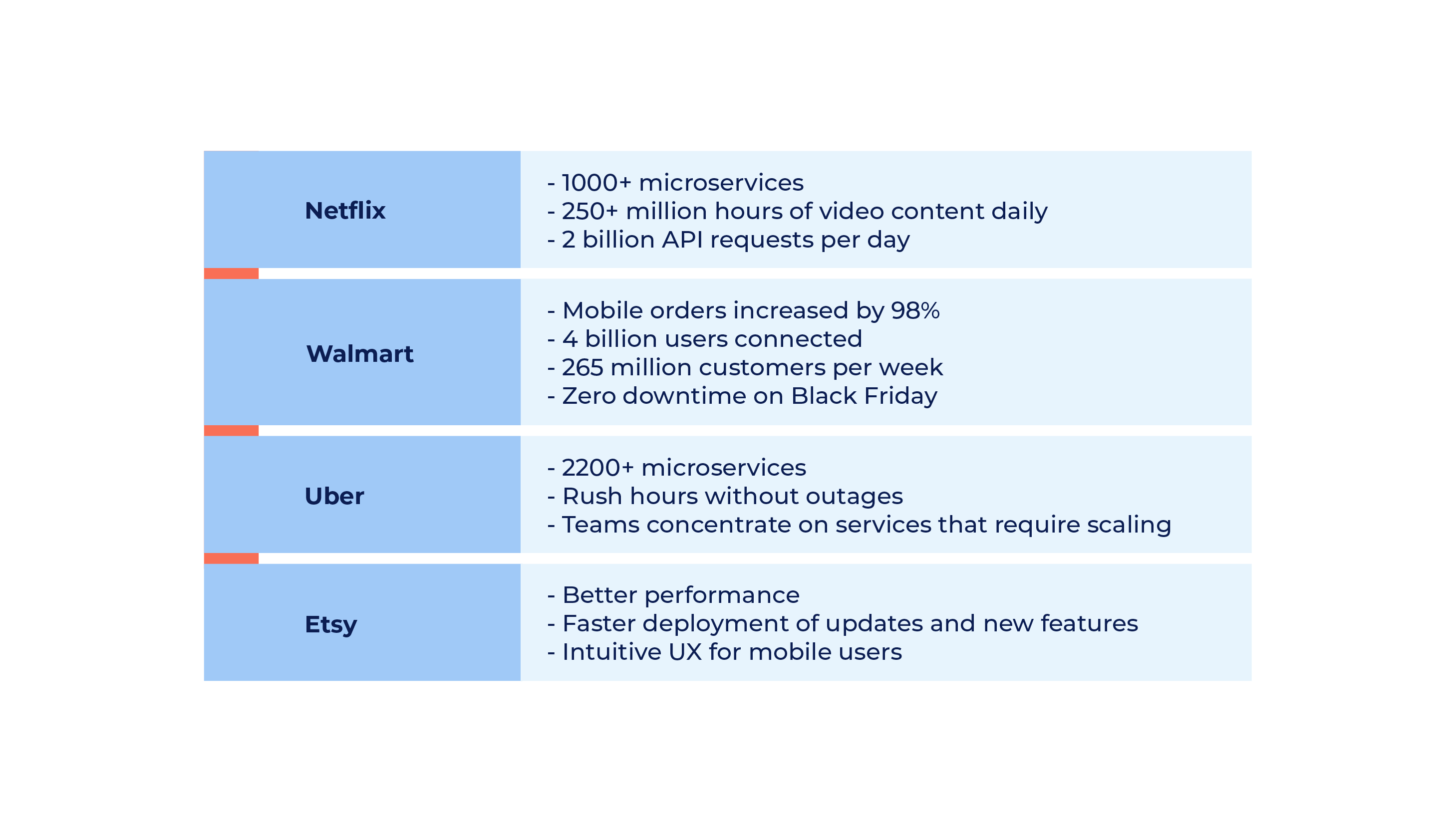
-
Uber
Uber’s transition to a microservices architecture came after the company faced the issue of launching new features and fixing bugs. Its monolithic architecture was too complex so that even minor changes required lots of effort and time.
When the app gained more popularity, it became challenging to maintain such a huge monolithic system.
Once Uber moved to cloud-based microservices and built unique components for various functions, from scheduled rides to passenger management, the company got a fault-tolerant system, achieved better scalability, and could update independent services without affecting the whole app.
Now, with over 2200 microservices, Uber can handle rush hours without outages and lets developers concentrate on services that require scaling rather than the entire application.
-
Etsy
Etsy started implementing microservices after they faced major issues with server processing time. The company set ambitious goals of boosting processing speed and making the platform suitable for upcoming mobile app features.
To solve these issues, Etsy decided to set up a two-layer API with meta-endpoints as a major component accessible for engineers. The overall performance depends on API’s capacity to communicate with endpoints.
To make this transition easier, the company also came up with a wide range of internal tools for developers to help them adopt the two-layer API and improve performance. As a result, Etsy managed to boost its performance, deploy updates and new features faster, and make UX more intuitive for smartphone users.
Scale Your Business With Cutting-Edge Microservices Solutions
Microservices architecture has become so popular as it’s a great approach to building complex and functional software products that include sets of independently deployable services. With our vast pool of tech talents, you can hit the market with scalable, user-friendly, and profitable microservices-based solutions. All you have to do is share your ambitious ideas with us and we will turn them into profitable ventures!


